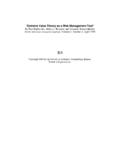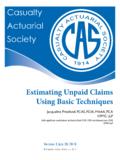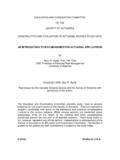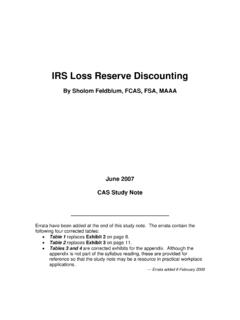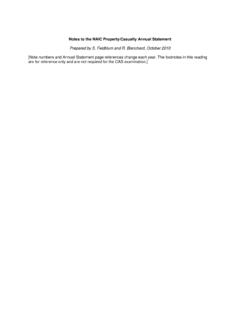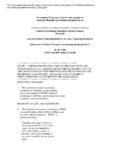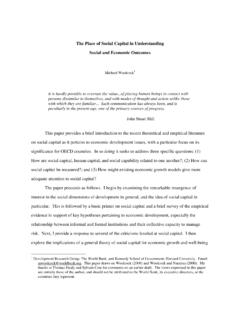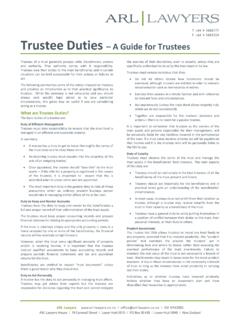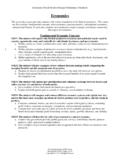Transcription of SYLLABUS OF BASIC EDUCATION 2018 Estimation …
1 SYLLABUS OF BASIC EDUCATION 2018 Estimation of policy liabilities , insurance company valuation , and Enterprise Risk management Exam 7 Materials for Study, 2018 Exam 7 Exam 7-1 2017, Casualty Actuarial Society, All Rights Reserved Casualty Actuarial Society, 4350 North Fairfax Drive, Suite 250, Arlington, VA 22203 The SYLLABUS for this four-hour exam is defined in the form of learning objectives, knowledge statements, and readings. LEARNING OBJECTIVES set forth, usually in broad terms, what the candidate should be able to do in actual practice. Included in these learning objectives are certain methodologies that may not be possible to perform on an examination, such as complex simulations, but that the candidate would still be expected to explain conceptually in the context of an examination. KNOWLEDGE STATEMENTS identify some of the key terms, concepts, and methods that are associated with each learning objective.
2 These knowledge statements are not intended to represent an exhaustive list of topics that may be tested, but they are illustrative of the scope of each learning objective. READINGS support the learning objectives. It is intended that the readings, in conjunction with the material on earlier examinations, provide sufficient resources to allow the candidate to perform the learning objectives. Some readings are cited for more than one learning objective. The CAS SYLLABUS & Examination Committee emphasizes that candidates are expected to use the readings cited in this SYLLABUS as their primary study materials. Thus, the learning objectives, knowledge statements, and readings complement each other. The learning objectives define the behaviors, the knowledge statements illustrate more fully the intended scope of the learning objectives, and the readings provide the source material to achieve the learning objectives.
3 Learning objectives should not be seen as independent units, but as building blocks for the understanding and integration of important competencies that the candidate will be able to demonstrate. Note that the range of weights shown should be viewed as a guideline only. There is no intent that they be strictly adhered to on any given examination the actual weight may fall outside the published range on any particular examination. The overall section weights should be viewed as having more significance than the weights for the individual learning objectives. Over a number of years of examinations, absent changes, it is likely that the average of the weights for each individual overall section will be in the vicinity of the guideline weight. For the weights of individual learning objectives, such convergence is less likely. On a given examination, in which it is very possible that not every individual learning objective will be tested, there will be more divergence of guideline weights and actual weights.
4 Questions on a given learning objective may be drawn from any of the listed readings, or a combination of the readings. There may be no questions from one or more readings on a particular exam. After each set of learning objectives, the readings are listed in abbreviated form. Complete text references are provided at the end of this exam SYLLABUS . Items marked with a bold SK or SKU constitute the 2018 Exam 7 Study Kit that may be purchased from the CAS Online Store. The 2018 Update to the 2017 Study Kit includes only the new items marked with a bold SKU; the Update may be purchased from the CAS Online Store. Items marked with a bold OP (Online Publication) are available at no charge and may be downloaded from the CAS website. Please check the SYLLABUS Updates section of the CAS Web Site for any changes to the SYLLABUS .
5 SYLLABUS OF BASIC EDUCATION 2018 Estimation of policy liabilities , insurance company valuation , and Enterprise Risk management Exam 7 Materials for Study, 2018 Exam 7 Exam 7-2 A. Estimation of policy liabilities Range of weight for Section A: 65-75 percent This section focuses on advanced techniques that the actuary may need to estimate reserves for unpaid claims. The candidate is expected to be well versed in the BASIC Principles and Standards of Practice for unpaid claim Estimation . This section addresses how actuarial concepts are adapted to evaluate liabilities arising in complex risk transfer agreements common in excess insurance and reinsurance contracts. Emphasis is placed on developing ranges around a best estimate. LEARNING OBJECTIVES KNOWLEDGE STATEMENTS 1. Calculate unpaid claim estimates using credibility models. a. Application of credibility b.
6 Mechanics of the methods (including loss ratio based payout factors) c. Strengths and weaknesses d. Testing results for reasonableness Range of weight: 10-14 percent READINGS Brosius H rlimann Mack (2000) SYLLABUS OF BASIC EDUCATION 2018 Estimation of policy liabilities , insurance company valuation , and Enterprise Risk management Exam 7 Materials for Study, 2018 Exam 7 Exam 7-3 LEARNING OBJECTIVES KNOWLEDGE STATEMENTS 2. Estimate parameters and unpaid claims using claims development models related to loss reserving methods such as: Chain ladder Cape Cod Chain ladder plus calendar-year effects Bornhuetter-Ferguson 3. Calculate the moments and percentiles of unpaid claim distributions implied by the models. a. Key assumptions of the models and testing of assumptions b. Original Mack chain ladder assumptions c. Relationship of variance assumptions to methods of calculating development factors d.
7 Row-factor, column-factor, and combined row- times column-factor models e. Calendar-year effects in development factor models and in row-column factor models f. Effect of trends and their interrelationship ( , calendar year, accident year, and development year trends) g. Testing for and eliminating insignificant parameters h. Testing whether the methods work and how well the models fit (including both one-tail and two-tail tests) i. Moments of the chain ladder unpaid claim estimate when factors are calculated based on different variance assumptions j. Simulation of parameter percentiles and unpaid claims percentiles when models assume a distribution of residuals fit by MLE Range of weight for Learning Objectives and collectively: 16-18 percent READINGS Clark Mack (1994) Venter Factors SYLLABUS OF BASIC EDUCATION 2018 Estimation of policy liabilities , insurance company valuation , and Enterprise Risk management Exam 7 Materials for Study, 2018 Exam 7 Exam 7-4 LEARNING OBJECTIVES KNOWLEDGE STATEMENTS 4.
8 Estimate unpaid claims for various layers of claims. a. Methods for estimating unpaid claims in a deductible layer, excess of a threshold, and excess of a retention but bounded by a limit b. Interrelationships between parameters and development patterns for forecasting deductible, unlimited excess, layer excess and total claims Range of weight: 5-7 percent READINGS Sahasrabuddhe Siewert LEARNING OBJECTIVES KNOWLEDGE STATEMENTS 5. Describe the various sources of risk and uncertainty that are associated with the determination of reserves. Calculate risk margins that consider these sources of risk and uncertainty. a. Systemic risks and independent risks b. Limitations of quantitative risk assessment c. Risk correlations d. Testing and evaluation of risk models 6. Calculate the mean and prediction error of a reserve given an underlying statistical model. a. Distributions and distribution-free models b.
9 Comparison of Chain Ladder stochastic models 7. Derive predictive distributions using bootstrapping and simulation techniques. a. Comparison of methods b. Simulation using bootstrapping c. Simulation from parameters d. Bayesian methods 8. Identify data issues and related model adjustments for reserving models. 9. Test assumptions underlying reserve models. 10. Develop a distribution of reserves using weights and multiple stochastic models. a. Bayesian methods b. Adjustments to various reserving techniques c. Comparison of ODP Bootstrap and GLM Bootstrap models Range of weight for Learning Objectives through collectively: 22-24 percent READINGS Marshall et al. Shapland Verrall Meyers (2015) SYLLABUS OF BASIC EDUCATION 2018 Estimation of policy liabilities , insurance company valuation , and Enterprise Risk management Exam 7 Materials for Study, 2018 Exam 7 Exam 7-5 LEARNING OBJECTIVES KNOWLEDGE STATEMENTS 11.
10 Compare and contrast reinsurance and primary reserving procedures. 12. Adjust primary methods and data to be used for reinsurance reserving. 13. Calculate ceded loss reserves using appropriate methods. a. Reinsurance and primary reserving methods b. Effect on assumptions from differences in information available to reinsurers c. Stanard-Buhlmann (Cape Cod) method d. Underlying business characteristics of reinsurance contracts, , concentration of exposures e. Data structures, , Ground up versus Excess loss, Accident Year versus Treaty Year Range of weight for Learning Objectives through collectively: 6-9 percent READINGS Patrik LEARNING OBJECTIVES KNOWLEDGE STATEMENTS 14. Forecast Premium Reserves. a. Reserves for retrospective premiums Range of weight: 4-5 percent READINGS Teng and Perkins SYLLABUS OF BASIC EDUCATION 2018 Estimation of policy liabilities , insurance company valuation , and Enterprise Risk management Exam 7 Materials for Study, 2018 Exam 7 Exam 7-6 B.
